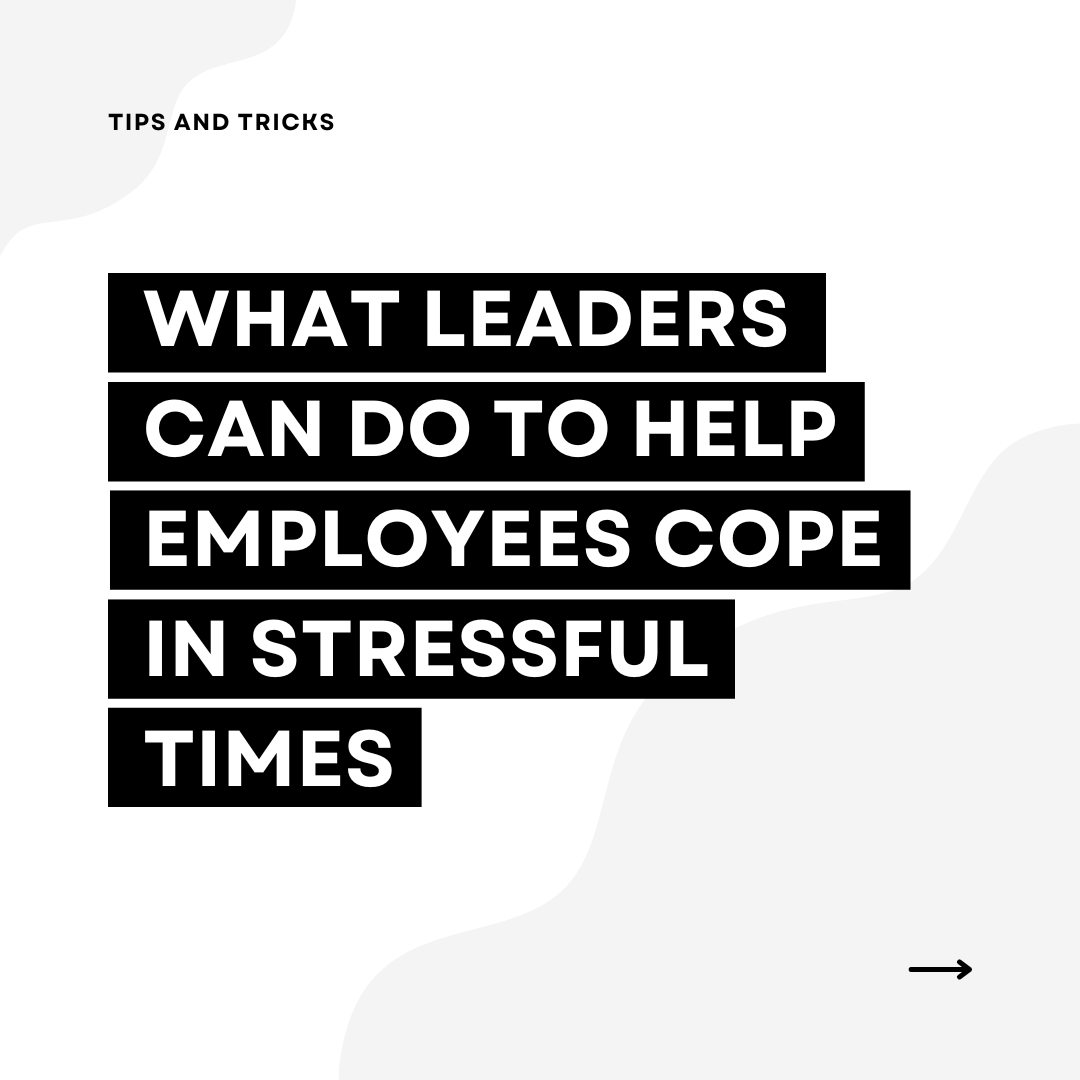[2023-06-23] Helping employees cope with change
Today, I came across a post by The Present Psychologist about What Drains Our Batteries at Work? Among the items on the list were not having a purpose, being overloaded, and not being challenged. Interestingly, change wasn't on the list. This could be because workplaces are often in a state of change, and that change—in and of itself—isn't what causes most employees stress. Instead, the culprit is frequently unexplained changes, when employees neither know what is happening nor understand why. Today, I came across a post by The Present Psychologist about What Drains Our Batteries at Work? Among the items on the list were not having a purpose, being overloaded, and not being challenged. Interestingly, change wasn't on the list. This could be because workplaces are often in a state of change, and that change—in and of itself—isn't what causes most employees stress. Instead, the culprit is frequently unexplained changes, when employees neither know what is happening nor understand why.
A decade ago, I wrote a Café Jen post proposing seven things managers can do to help their employees cope with change. I've dusted off, and expanded, that blog post for tonight's Jenesis entry.
Emotions are contagious
Writing in the Harvard Business Review, Tony Schwartz notes that emotions are contagious, but "a leader's feelings are disproportionately contagious."
That's a powerful statement, reminiscent of the adage that an immediate supervisor is, to their employees, the most important person in the workplace. This is especially true during a major change, when a boss can be a crucial source of information about what's happening and why, as well as how things will change.
Similarly, Sheldon Gordon notes in a Globe and Mail article that "Our feelings are felt by other people. If [a manager] is calm around you, you tend to be calmer." A boss can lower stress in their employees by managing their own stress levels, says Gordon. They can also raise stress levels if they're not careful.
This is especially the case during times of transition. Gordon notes that "A reorganization or downsizing is stressful for employees, but managers make things worse if they fail to help employees understand what is actually driving the changes."
Gordon quotes Lynda Miller of Overloaded Enterprises in Toronto who says executives need to create a "culture of hope and positivity." She continues, "Really good change management helps people understand why things happen, not just what is happening. They may not necessarily agree with what’s going on, but if they understand what’s behind it, they may be able to adapt better."
All change is stressful at some level but not all change stems from a negative situation. Sometimes change occurs when an organization is successful, which can lead to more work and new or higher expectations.
Such was the case for Tony Schwartz and the employees of his company, The Energy Project. As Schwartz explains in his post in the Harvard Business Review blog, his employees complained at an all-staff meeting that they were feeling overloaded ever since the company took on more and more work. Despite his own feelings of defensiveness, Schwartz listened to the group's feedback. They agreed to ruthlessly prioritize their work and hire more staff.
As the meeting came to a close, however, Schwartz sensed that his employees' feelings of frustration and fatigue lingered. Without dismissing the legitimate issues his staff had raised, Schwartz pointed out that their predicament was ultimately the result of their success. He reminded them of the opportunity they had to fulfill their mission of helping companies transform their workplaces. One of the employees then suggested they each share something they were feeling good about at work. As each employee commented, the mood lifted and the meeting ended with a shared sense of inspiration. For Schwartz, this was an example of the power of positive emotions.
What leaders can do to help employees cope in stressful times
Whether the stress employees are feeling is the result of a negative or positive change, leaders can help their employees cope. Here are seven tips I gleaned from the two articles for how managers can lessen the stress their staff are experiencing.
- Start by managing your own stress. Gordon quotes Marianna Paulson, a Vancouver stress management coach who says, "The person who is in charge needs to set a precedent by looking after themselves." That includes taking time away from the office in the evenings, on weekends and during regularly scheduled holidays to re-energize.
- Ask what's going right. Schwartz argues that this becomes a valuable counter-balance to our natural tendency to see the negative in situations.
- But don't squelch negative emotions either. "Doing so only makes the feelings go underground," says Schwartz. "Invariably, they show up later, more covertly, in the form of disengagement, simmering resentment, and passive aggressive behaviors that poison the workplace."
- Give employees a safe place to vent negative emotions without fear. This could be a staff meeting or via comments aggregated by an advisor. When people feel their concerns are being heard, writes Schwartz, they're much more likely to share what's going on, which allows the organization to address the real issues.
- Understand and show appreciation for what your employees are going through. At the same time, says Gordon, avoid projecting a sense of doom and gloom. I've always found this to be a tricky balance to get right. If leaders project only positive messages during a difficult transition, they risk appearing out of touch with their employees, and staff may discount everything they say. But if they focus too much on the negative, they may add to their employees’ stress. I usually try to be realistic but hopeful.
- Don't ask for miraculous effort all the time. I have found that most employees are happy to go the extra mile when asked. But bosses need to be careful not to overuse this willingness. Working beyond capacity for extended periods of time leads to burnout.
- Above all, model positive energy. Because emotions are contagious, says Schwartz, leaders should project the energy they want to see from their employees.
The seven tips remind me of an occasion when I was a new executive (in fact, I was only acting in the job). My boss had asked me to lead a review of my IT team to determine whether we should transfer responsibility for the group to a unit at the departmental level. While the review was not likely to end in job losses, the team was aware that they might be amalgamated into a larger team. They were worried.
I knew that the employees were unhappy about the review and felt that it was being done to them. I committed to meeting with them every week to provide an update on the project and to address their concerns. They asked a lot of questions, particularly in the early weeks. But they also provided valuable input into the review. They made suggestions about whose views should be sought and asked that the consultant present the review findings to them before sharing them with senior management. Their ideas improved the project, and our weekly conversations built trust, which was important because I was a new director. What I learned from that experience, I applied throughout the rest of my career:
- When a change is occurring, spend time with employees. Build a relationship with them. Answer uncomfortable questions. Listen. Show that you care. Be realistic, but also offer hope.
- Commit to a timetable for communication, ideally face to face. That could be daily, weekly, monthly. Just pick a schedule and stick to it, even if you think you don't have much to say. See every discussion as an opportunity to listen as much as to communicate, and as a chance to enhance trust.
- Hear employees' concerns and, whenever possible, make adjustments to address their feedback. More than anything, a willingness to alter the game plan shows that you're listening, that employees' input is valuable and that you genuinely want to help them through the transition phase.

A decade ago, I wrote a Café Jen post proposing seven things managers can do to help their employees cope with change. I've dusted off, and expanded, that blog post for tonight's Jenesis entry.
Emotions are contagious
Writing in the Harvard Business Review, Tony Schwartz notes that emotions are contagious, but "a leader's feelings are disproportionately contagious."
That's a powerful statement, reminiscent of the adage that an immediate supervisor is, to their employees, the most important person in the workplace. This is especially true during a major change, when a boss can be a crucial source of information about what's happening and why, as well as how things will change.
Similarly, Sheldon Gordon notes in a Globe and Mail article that "Our feelings are felt by other people. If [a manager] is calm around you, you tend to be calmer." A boss can lower stress in their employees by managing their own stress levels, says Gordon. They can also raise stress levels if they're not careful.
This is especially the case during times of transition. Gordon notes that "A reorganization or downsizing is stressful for employees, but managers make things worse if they fail to help employees understand what is actually driving the changes."
Gordon quotes Lynda Miller of Overloaded Enterprises in Toronto who says executives need to create a "culture of hope and positivity." She continues, "Really good change management helps people understand why things happen, not just what is happening. They may not necessarily agree with what’s going on, but if they understand what’s behind it, they may be able to adapt better."
All change is stressful at some level but not all change stems from a negative situation. Sometimes change occurs when an organization is successful, which can lead to more work and new or higher expectations.
Such was the case for Tony Schwartz and the employees of his company, The Energy Project. As Schwartz explains in his post in the Harvard Business Review blog, his employees complained at an all-staff meeting that they were feeling overloaded ever since the company took on more and more work. Despite his own feelings of defensiveness, Schwartz listened to the group's feedback. They agreed to ruthlessly prioritize their work and hire more staff.
As the meeting came to a close, however, Schwartz sensed that his employees' feelings of frustration and fatigue lingered. Without dismissing the legitimate issues his staff had raised, Schwartz pointed out that their predicament was ultimately the result of their success. He reminded them of the opportunity they had to fulfill their mission of helping companies transform their workplaces. One of the employees then suggested they each share something they were feeling good about at work. As each employee commented, the mood lifted and the meeting ended with a shared sense of inspiration. For Schwartz, this was an example of the power of positive emotions.
What leaders can do to help employees cope in stressful times
Whether the stress employees are feeling is the result of a negative or positive change, leaders can help their employees cope. Here are seven tips I gleaned from the two articles for how managers can lessen the stress their staff are experiencing.
- Start by managing your own stress. Gordon quotes Marianna Paulson, a Vancouver stress management coach who says, "The person who is in charge needs to set a precedent by looking after themselves." That includes taking time away from the office in the evenings, on weekends and during regularly scheduled holidays to re-energize.
- Ask what's going right. Schwartz argues that this becomes a valuable counter-balance to our natural tendency to see the negative in situations.
- But don't squelch negative emotions either. "Doing so only makes the feelings go underground," says Schwartz. "Invariably, they show up later, more covertly, in the form of disengagement, simmering resentment, and passive aggressive behaviors that poison the workplace."
- Give employees a safe place to vent negative emotions without fear. This could be a staff meeting or via comments aggregated by an advisor. When people feel their concerns are being heard, writes Schwartz, they're much more likely to share what's going on, which allows the organization to address the real issues.
- Understand and show appreciation for what your employees are going through. At the same time, says Gordon, avoid projecting a sense of doom and gloom. I've always found this to be a tricky balance to get right. If leaders project only positive messages during a difficult transition, they risk appearing out of touch with their employees, and staff may discount everything they say. But if they focus too much on the negative, they may add to their employees’ stress. I usually try to be realistic but hopeful.
- Don't ask for miraculous effort all the time. I have found that most employees are happy to go the extra mile when asked. But bosses need to be careful not to overuse this willingness. Working beyond capacity for extended periods of time leads to burnout.
- Above all, model positive energy. Because emotions are contagious, says Schwartz, leaders should project the energy they want to see from their employees.
The seven tips remind me of an occasion when I was a new executive (in fact, I was only acting in the job). My boss had asked me to lead a review of my IT team to determine whether we should transfer responsibility for the group to a unit at the departmental level. While the review was not likely to end in job losses, the team was aware that they might be amalgamated into a larger team. They were worried.
I knew that the employees were unhappy about the review and felt that it was being done to them. I committed to meeting with them every week to provide an update on the project and to address their concerns. They asked a lot of questions, particularly in the early weeks. But they also provided valuable input into the review. They made suggestions about whose views should be sought and asked that the consultant present the review findings to them before sharing them with senior management. Their ideas improved the project, and our weekly conversations built trust, which was important because I was a new director. What I learned from that experience, I applied throughout the rest of my career:
- When a change is occurring, spend time with employees. Build a relationship with them. Answer uncomfortable questions. Listen. Show that you care. Be realistic, but also offer hope.
- Commit to a timetable for communication, ideally face to face. That could be daily, weekly, monthly. Just pick a schedule and stick to it, even if you think you don't have much to say. See every discussion as an opportunity to listen as much as to communicate, and as a chance to enhance trust.
- Hear employees' concerns and, whenever possible, make adjustments to address their feedback. More than anything, a willingness to alter the game plan shows that you're listening, that employees' input is valuable and that you genuinely want to help them through the transition phase.



